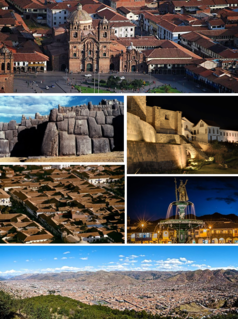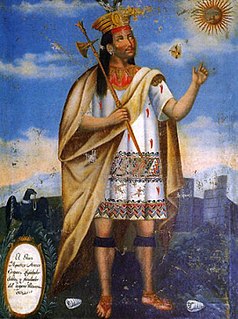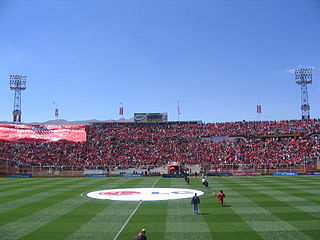Related Research Articles

Cusco, often spelled Cuzco, is a city in southeastern Peru near the Urubamba Valley of the Andes mountain range. It is the capital of the Cusco Region and of the Cusco Province. The city is the seventh most populous in Peru and, in 2017, had a population of 428,450. Its elevation is around 3,400 m (11,200 ft).

Manco Cápac, also known as Manco Inca and Ayar Manco was, according to some historians, the first governor and founder of the Inca civilization in Cusco, possibly in the early 13th century. He is also a main figure of Inca mythology, being the protagonist of the two best known legends about the origin of the Inca, both of them connecting him to the foundation of Cusco. His main wife was his older sister, Mama Uqllu, also the mother of his son and successor Sinchi Ruq'a. Even though his figure is mentioned in several chronicles, his actual existence remains uncertain.

The Inca road system was the most extensive and advanced transportation system in pre-Columbian South America. It was at least 40,000 kilometres (25,000 mi) long. The construction of the roads required a large expenditure of time and effort.

Sacsayhuamán, which can be spelled many different ways, is a citadel on the northern outskirts of the city of Cusco, Peru, the historic capital of the Inca Empire.

Inca Garcilaso de la Vega, born Gómez Suárez de Figueroa and known as El Inca, was a chronicler and writer born in the Viceroyalty of Peru. Sailing to Spain at 21, he was educated informally there, where he lived and worked the rest of his life. The natural son of a Spanish conquistador and an Inca noblewoman born in the early years of the conquest, he is known primarily for his chronicles of Inca history, culture, and society. His work was widely read in Europe, influential and well received. It was the first literature by an author born in the Americas to enter the western canon.

Estadio Inca Garcilaso de la Vega, commonly known as Estadio Garcilaso, is Cusco's principal stadium and the home venue of the local football team Cienciano. The stadium was named after the Peruvian mestizo Inca Garcilaso de la Vega and inaugurated in 1958, with an initial capacity of 30,000. It is owned by the Instituto Peruano del Deporte.

The Inti Raymi is a traditional religious ceremony of the Inca Empire in honor of the god Inti, the most venerated deity in Inca religion. It was the celebration of the winter solstice – the shortest day of the year in terms of the time between sunrise and sunset – and the Inca New Year, when the hours of light would begin to lengthen again. In territories south of the equator, the Gregorian months of June and July are winter months. It is held on June 24.

Inca architecture is the most significant pre-Columbian architecture in South America. The Incas inherited an architectural legacy from Tiwanaku, founded in the 2nd century B.C.E. in present-day Bolivia. A core characteristic of the architectural style was to use the topography and existing materials of the land as part of the design. The capital of the Inca empire, Cuzco, still contains many fine examples of Inca architecture, although many walls of Inca masonry have been incorporated into Spanish Colonial structures. The famous royal estate of Machu Picchu is a surviving example of Inca architecture. Other significant sites include Sacsayhuamán and Ollantaytambo. The Incas also developed an extensive road system spanning most of the western length of the continent and placed their distinctive architecture along the way, thereby visually asserting their imperial rule along the frontier.

Raúl Porras Barrenechea was a Peruvian diplomat, historian and politician. He was President of the Senate in 1957 and Minister of Foreign Affairs between 1958 and 1960. A well-known figure of the student movement in San Marcos in the early 20th century, Porras became one of the most prominent hispanist historians of his generation and a leading figure of the Peruvian diplomacy.

Coricancha, Koricancha, Qoricancha or Qorikancha was the most important temple in the Inca Empire. It is located in Cusco, Peru, which was the capital of the empire.

Paruro Province is one of thirteen provinces in the Cusco Region in the southern highlands of Peru.
San Sebastián District is one of eight districts of the Cusco Province in Peru.
Conchucos District is one of eleven districts of the Pallasca Province in Peru.
Pedro de Candia was a Greek explorer and cartographer at the service of the Kingdom of Spain, an officer of the Royal Spanish Navy that under the Spanish Crown became a Conquistador, Grandee of Spain, Commander of the Royal Spanish Fleet of the Southern Sea, Colonial Ordinance of Cusco, and then Mayor of Lima between 1534 and 1535. Specialized in the use of firearms and artillery, he was one of the earliers explorers of Panama and the Pacific coastline of Colombia, and finally participated in the conquest of Peru. He was killed in the Battle of Chupas, (Peru), on 16 September 1542, by Diego de Almagro II.

Deportivo Garcilaso is a Peruvian football club, playing in the city of Cusco, Peru. The club was founded in 1957 and plays in the Copa Perú which is the "third division" of the Peruvian league.

Cusco Fútbol Club is a professional Peruvian football club based in the city of Cusco, that competes in the Liga 1, the top flight of Peruvian football.

Muyuq Marka, also Muyuqmarka, is an archaeological site in Peru. It is the base of what was a round Incan tower, which is situated within the fortress Saksaywaman above Cuzco. It was used as a Temple of Inti, but became part of a complex of rectangular buildings which mostly still remain today. However, the temple and the two flanking towers were dismantled during the Spanish rule. What remains of Muyuq Marka indicates that it was "a round building with an open central court which had a fountain." The temple had triple walls, which were aligned with the zenith sunrise and the antizenith sunset.
The 2015 Torneo Descentralizado de Fútbol Profesional is the 99th season of the highest division of Peruvian football. A total of 17 teams have been confirmed to compete in the season after Alianza Atlético were reinstated in the first division following their relegation in 2011.
Qhapaq Kancha is an archaeological site in Peru of the Inca period on top of a mountain of the same name. It is located in the Cusco Region, Calca Province, Coya District.
References
- ↑ Rodolfo Cerrón-Palomino, Las etimologías toponímicas del Inca Garcilaso, Revista Andina 38, Las etimologás toponímicas del Inca Garcilaso, Cuzco, Peru, 2004
- ↑ Plan de Desarollo Urbano Cusco al 2023, Municipalidad Provincial del Cusco, 2.5. Componente Arqueología - Cultura, p. 274
- ↑ Sign at Puqin Kancha